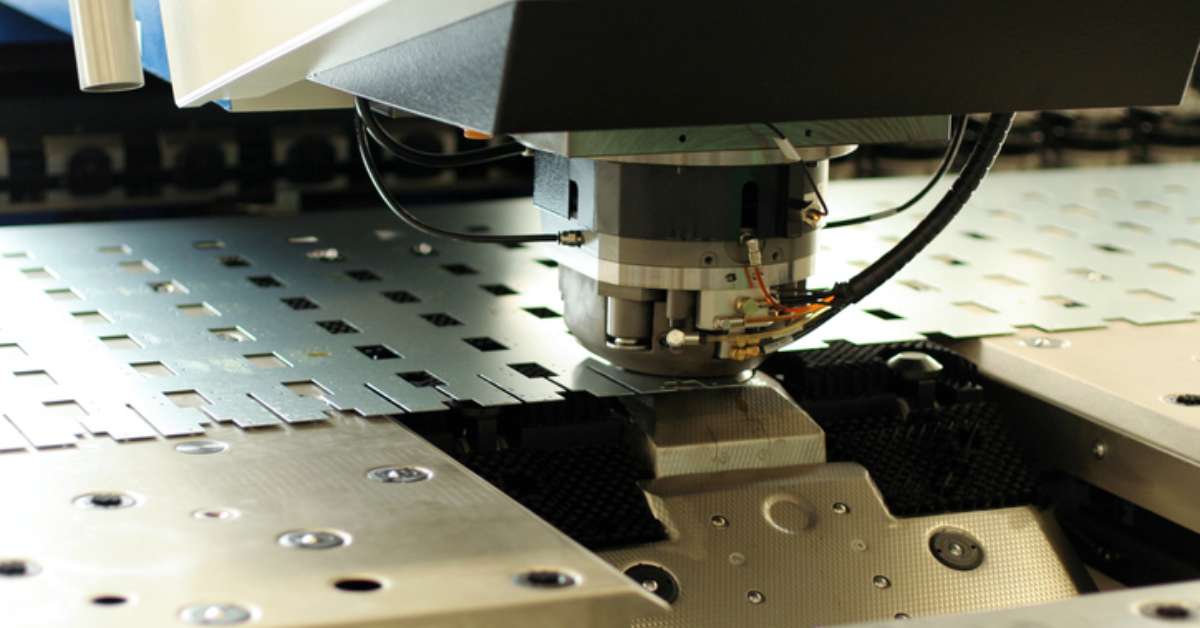Do you know how small metal parts are created with such precision in stamping process sheet metal? Blanking dies play an important role in transforming these metal sheets into the parts we see in everyday objects.
Blanking dies in sheet metal stamping are specialized tools used to cut specific shapes out of a metal sheet. The die contains a punch and a die cavity, and when pressure is applied, the metal is sheared into the desired shape, leaving behind scrap.
Keep reading as we break down how these dies work and their various applications in different industries.We’ll also discuss their advantages and share some maintenance tips.
Understanding Blanking Dies in Sheet Metal Stamping
If you’re interested in metal fabricating, you should understand the use of blanking dies in sheet metal stamping. The main function of the dies is producing perfectly shaped parts from larger sheets. And the process also ensures the precision of parts and reduces waste.
Let’s find out how these dies play a vital role in creating high-quality metal components.
What Are Blanking Dies?
A blanking die is a special tool used in sheet metal fabrication to cut out specific shapes from a larger piece of metal, such as aluminum, steel, or copper. It helps sheet metal fabricators produce parts fast with high quality.
A blanking die consists of a few key components: the die itself, the punch, and the guide plate. During the stamping process, a metal sheet is placed under the punch and die setup. The die is usually a stationary part, with a cavity that’s a bit bigger than the punch.
When the punch comes down with a lot of force, it shears off the metal, creating a precise part. The part that gets cut out is the “blank,” and the leftover metal, often called the “web,” usually gets discarded as scrap or reused for something else.
Why do we use blanking dies? Well, they’re great for producing high volumes of parts quickly, with minimal waste. The speed of the process makes it a go-to method in industries like automotive and electronics. However, it’s not without its downsides. For one, blanking dies can be pretty expensive to make, and the edges of the parts often need some additional work to smooth out any burrs left over from the cutting process.
Applications of Blanking Dies in Metal Fabrication
In sheet metal fabrications, you’ll see various types of uses of blanking dies. Here, we’ve discussed some of the most common applications.
a. Automotive Industry
Sheet metal blanking is used for manufacturing different car parts. For example, body panels, like car doors and hoods, are stamped from metal sheets. The blanking process ensures that every piece is precise, with the right curves and angles for a smooth fit.
Plus, the same process is used to create internal components, such as dashboard frames and seat structures. These parts need to be exact. Otherwise, different parts won’t line up during assembly. So, metal blanking guarantees a tight fit. And let’s not forget the smaller, intricate engine parts that blanking helps craft, from transmission gears to heat shields.
b. Electronics and Appliances
Ever thought about how your washing machine or microwave gets its sturdy, sleek exterior? Blanking dies in sheet metal stamping are behind those durable casings.
In electronics, you’ll see its use in making circuit board shields that protect your electronics from electrical interference. Blanking helps create heatsinks’ finned metal pieces that help cool down high-performance electronics. It also manufactures small parts, such as brackets and connectors, with precision.
c. Aerospace Applications
Blanking produces fuselage panels and wing components that meet aerodynamic standards. It also produces fan blades and turbine disks that require strict tolerances. Even interior components, such as seating structures or overhead bins, are made using this process. These parts need to meet both safety and aesthetic standards, and blanking delivers.
d. Construction Applications
Think about structural components that support buildings or bridges. They are often made using blanking dies, ensuring they provide the right strength and stability. Roofing and cladding panels, which protect buildings from weather, are created using this process too. It also extends to HVAC systems, where air ducts and vents are shaped to guide airflow efficiently.
Advantages of Blanking Dies for High-Volume Production
When you’re manufacturing hundreds and thousands of parts, the last thing you want is inefficiency slowing you down. You can choose blanking dies for the stamping process because it’s a good choice for high-volume production:
i. Speed and Efficiency
Blanking dies are designed for high-speed operation. With just one press, you can create multiple parts in no time. This makes the process perfect for industries that need quick production. The faster you can produce parts, the quicker you can move to the next phase of manufacturing. Plus, fewer interruptions mean higher overall productivity.
ii. Consistent Quality
One of the best parts about blanking is the consistency it brings. Each part that comes out of the press looks almost identical to the last, with the same dimensions and quality. This is a great advantage when you need a high volume of identical components, like those used in cars or planes.
iii. Cost-Effective
Sure, the initial investment in blanking dies and tooling might seem steep, but the long-term savings are well worth it. The beauty of blanking is that once the tooling is set up, the operational costs are low, and the output rate is high. This means that as you scale production, the cost per part decreases.
iv. Versatility Across Materials
Whether it’s steel, aluminum, copper, or even brass, blanking dies can handle a variety of metals. This gives manufacturers the flexibility to work with different materials depending on the project at hand. No matter the material, the process adapts to produce the exact shapes and components required for the job.
v. Low Maintenance but High Output
One of the underrated benefits of blanking dies is their durability. Punches and dies are made from hardened steel, so they’re tough and resistant to wear. This means fewer breakdowns, lower maintenance costs, and more uptime for your production line. Less downtime is equal to more parts, which is exactly what you want when you’re pushing out high volumes of products.
Maintenance Tips for Long-Term Blanking Die Performance
Maintaining the blanking dies is necessary to keep them running smoothly and prevent unnecessary downtime. Here are some simple tips you can follow:
1. Keep It Clean
It sounds basic, but trust us, regular cleaning is super important. Blanking dies accumulate metal chips, debris, and old lubricant that can affect performance. A quick clean-up after each job will prevent these tiny particles from causing major problems. When debris builds up, it can cause friction, leading to scoring or wear.
Use a soft brush and cleaning solution that’s safe for your die material. It doesn’t take long and keeps things running smoothly.
2. Apply Lubrication
Without the right lubrication, your die’s moving parts will suffer. Friction leads to wear, and over time, that’ll mess with your die’s precision. Apply a lubricant regularly to keep everything gliding smoothly. Choose a lubricant based on the material you’re blanking and the conditions the die is working under.
3. Sharpen Those Edges
Blunt punches and dies don’t just make a mess, they cost you money. Dull edges lead to poor cuts, burrs, and extra wear on the die itself. Do regular sharpening to keep the dies sharp and precise. You don’t need to do it after every shift, but make sure to check the edges periodically.
- Pro tip: If you’re not sure how to do this, get a professional who has the right tools and skills to restore the cutting edges.
4. Inspect Regularly and Replace Parts
Catching problems early can save you a ton of trouble later. Regularly inspect your blanking dies for signs of damage, like cracks, chips, or misalignment. If something seems off, don’t wait for it to get worse; address the issue right away. If you notice excessive wear, it might be time to replace certain parts.
Conclusion
Blanking dies in sheet metal stamping help with quick manufacturing of precision parts. The dies are great for plenty of high-demanding industries, including automotive and electronics. While the initial investment might be high, the long-term benefits of faster production, consistent quality, and low maintenance make them a solid choice.
At Zintilon, we specialize in custom precision parts, from sheet metal fabrication to CNC machining. You can rely on us if you want top-notch precision machining services. Reach out and get a quote for free.
Stay in touch to get more updates & alerts on Picnob! Thank you



